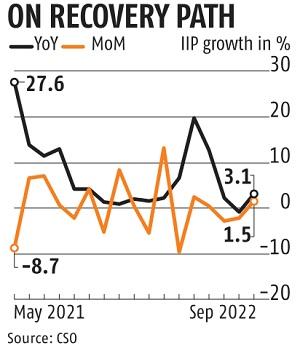
Growth in factory output recovered to a three-month high at 3.1 per cent in September as mining and electricity output grew at a robust pace even as global slowdown and elevated inflation dragged down growth in manufacturing output.
This recovery comes after a surprise contraction in August.Data released by the National Statistical Office (NSO) on Friday showed mining, manufacturing and electricity sectors grew at 4.6 per cent, 1.8 per cent and 11.6 per cent, respectively.Compared to pre-Covid levels, the index of industrial production (IIP) reported a healthy 8.6 per cent expansion in September.
It saw a rise in all categories except consumer non-durables.During the first half (April-September) of FY23, IIP grew 7 per cent against 23.8 per cent during the same period a year ago.
Nine out of 23 industries in the IIP tobacco, textiles, apparel, leather, wood, pharmaceuticals, plastic, electronics and electrical equipment registered contraction.The positive feature is the strong growth in the auto sector as well as non-electrical machinery with support from metals and non-metallic minerals.
Clearly, the momentum seen in the infra space has helped the cause here, said Madan Sabnavis, chief economist at Bank of Baroda.According to use-based industries, capital goods, which is a proxy for investment demand in the economy, grew at a robust 10.3 per cent.
Infrastructure goods rose 7.4 per cent due to greater capex push by the government.However, output in consumer durables (-4.5 per cent) and consumer non-durables (-7.1 per cent) contracted in September for the second and third consecutive months, respectively.
It signals continued weakness in demand in rural as well as urban India.Rajani Sinha, chief economist at CARE Ratings, said the strong growth recorded in capital goods and infrastructure is encouraging and hopefully a precursor to a pick up in the capex cycle.However, improvement in domestic consumption demand will be critical for sustained recovery in Indias growth momentum.
Hence, poor performance of IIP consumer durables and non-durables is worrisome.
Going forward, as inflation moderates, we are likely to see a pick-up in consumption demand, she added.Aditi Nayar, chief economist, ICRA, said high frequency indicators suggest easing of economic activity in October relative to September.This is owing to the relatively early onset of the festive season this year vis--vis 2021.
It is also because of the advancement of pre-festive stocking and shift in the holiday calendar.We expect the overall IIP growth to ease to sub-2 per cent in October, because of the higher number of holidays compared to October 2021.
This is also owing to the early onset of the festive season and flagging external demand, which are likely to have constrained the performance of the manufacturing sector during the month, she added.Sabnavis said he expects at best stable growth in the coming months.
It looks like while consumption has increased as indicated by GST (goods and services tax) collections, some part of the demand moved to the gold and jewellery segments, Sabnavis said.The International Monetary Fund (IMF), in its latest World Economic Outlook report, cut its forecast for Indias gross domestic product (GDP) growth for FY23 by 60 basis points (bps) to 6.8 per cent.
It warned of a long and tough economic winter.Last month, the Reserve Bank of India (RBI) also revised its growth forecast for FY23 to 7 per cent from 7.2 per cent earlier.The headwinds from extended geopolitical tension, tightening global financial conditions and possible decline in the external component of aggregate demand can pose downside risks to growth, said RBI Governor Shaktikanta Das last month, in his monetary policy statement.

 18
18






